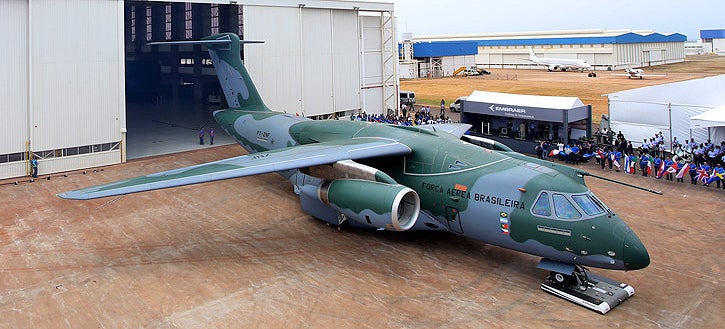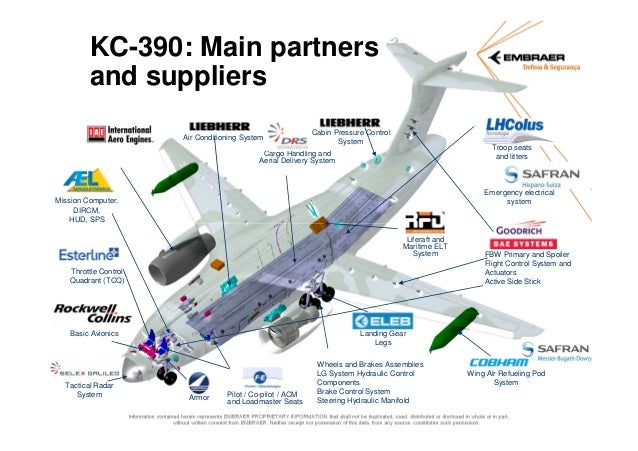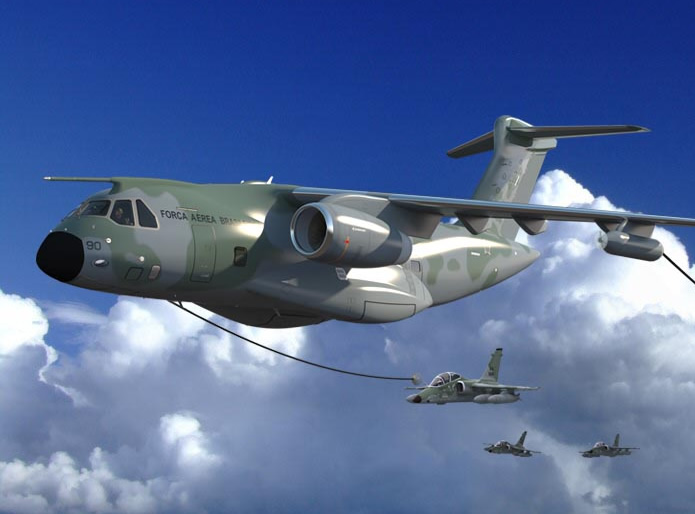The Embraer KC-390 is a medium-size, twin-engine jet-powered military transport aircraft under development by Embraer (Empresa Brasileira de Aeronáutica), one of the world's largest aircraft manufacturers, able to perform aerial refuelling and to transport cargo and troops. It is the heaviest aircraft that the company has made to date, and will be able to transport up to 21 t (23 tons) of cargo, including wheeled armoured fighting vehicles.
The new high-wing aircraft is expected to fly in 2014 and enter service by the end of 2016. With the launch of the KC-390, competition in the 20t air transport segment has intensified.
Features of the KC-390 will be in compliance with the new National Defence Strategy and meet the needs of the FAB. The new aircraft will replace 22 Lockheed Martin C-130E/H and KC-130 that are currently a part of the FAB.
KC-390 development
In 2006, Embraer began studies on a military tactical transport design of a similar size to the Lockheed C-130 Hercules. In April 2007, Embraer reported it was studying a medium-size airlifter, with the company designation "C-390". The transport aircraft is to incorporate many of the technological solutions from the Embraer E-Jets series and feature a rear ramp for loading and unloading a wide range of cargo. The unit price was estimated to be around US$50 million in 2007, while similar models, such as the C-130J cost up to $62 million.
The former president of Embraer Defence and Security, Luiz Carlos Aguiar, said that according to their estimates, some 695 military transport aircraft in the world will need to be replaced during the next decade, and that there is a large potential market for this kind of aircraft. Powerplant options have been studied in the 75.6 to 98 kN (17,000 to 22,000 lbf) thrust range, including engines such as the Pratt & Whitney PW6000 and Rolls-Royce BR715.
In March 2008, the Brazilian Government planned to invest about R$60 million (or US$33 M) in initial development of the aircraft and the Brazilian Air Force was simultaneously finalizing the purchase contract to probably buy 22 to 30 aircraft in the first order, while Embraer is negotiating with possible partners. In May 2008, the Brazilian Congress released 800 million Reais (US$440 M) to be invested in the project and development of the aircraft. The media also claimed that this aircraft is not only going to be used by the Brazilian Air Force, but also for Brazilian Army and Brazilian Navy, with un-confirmed sales to other government agencies.
Embraer intended to use components from the Embraer E-190 to allow for a quick development, but the Brazilian Air Force (paying the bill) demanded performance at least equal to the C-130. Before 2009, Embraer decided to develop the KC-390 from scratch, having nothing in common with the E-190. In Embraer's view, the jet engine is sufficiently resilient to dust ingestion, whereas propeller tips close to the ground are susceptible to damage. Embraer also chose the V2500 engines for efficiency in ordinary conditions rather than performance in unusual conditions.
On 14 April 2009, Embraer was awarded with a $1.5 billion contract to develop and build 2 prototypes. In March 2010, Embraer drew up a development schedule, with the first prototype aircraft scheduled to be delivered in late 2014.
In July 2010, during the Farnborough Airshow, the Brazilian Air Force announced it will order 28 KC-390s and Embraer announced an increase in the cargo capacity to 21 t (21 long tons; 23 short tons). During the 2011 Paris Air Show, Embraer announced plans to launch a stretched version of the KC-390 focused on the civil cargo market in 2018, with 200–250 predicted orders over a 10-year period. Two plugs will be added fore and aft of the centre fuselage section increasing internal capacity, but also providing for a side cargo door.
In August 2010, Argentine Defence Minister Nilda Garré announced that Argentina will participate in the construction of the C-390. On 24 August 2010 the defence ministers of Chile and Brazil signed an agreement for Chile's ENAER company to join the KC-390 industry team. Colombia also signed an agreement to join the KC-390 programme. On 10 September 2010 Portugal defense minister signed an intentions letter in order to join the programme.[ On 14 December 2011, Embraer announced that Brazil and Portugal have signed an agreement for defense partnership contract for EEA to support engineering for the KC-390's components that will be built by Embraer's subsidiary OGMA.
In June 2012, Boeing and Embraer agreed to a co-operation deal and to share technical knowledge, in order to speed development of the aircraft; exchanging technical and market information, and possibly teaming up for commercial opportunities, as part of a broader agreement that Boeing and Embraer signed in April of the same year.
Major subcontracted assemblies include the rear fuselage section (Aero Vodochody), avionics (Rockwell Collins), fly-by-wire primary flight control system (Goodrich Corporation) and the cargo handling and aerial delivery system (Rockwell Collins). IAE (International Aero Engines) is supplying the V2500-E5 turbofan, in the first military application of this engine family.
The first prototype rolled out from the Embraer subsidiary plant, Embraer Defense and Security, at Gavião Peixoto, São Paulo on 21 October 2014, and flew for the first time on 3 February 2015.
In July 2015 the company announced a two-year delay in the flight test program, certification is not expected until the second half of 2017 with an entry into service in 2018.
KC-390 technical details
The twin-turbofan-powered KC-390 can be refuelled in flight and can be used for in-flight or on-ground refuelling of other aircraft. The new 20t jet is technically advanced and has fly-by-wire technology, which optimises mission results thereby reducing pilot workload. It also helps increase the safety and capability for operating on short and rustic runways.
The KC-390 is also intended to compete directly with the Lockheed Martin C-130J Super Hercules on the military tactical airlifter market, and offers fierce competition for its American rival. Compared to the C-130J, the KC-390 is expected to be 15% faster, carry an 18% heavier payload, and cost 59% as much to purchase. And although having a 15% shorter range than the C-130J, the KC-390 has an aerial refueling capability as a standard feature (only a few specialized sub-variants of the C-130 have an aerial refueling capability).
Typical of a medium-sized and medium-range tactical airlifter, the KC-390 has a spacious, rectangular cargo bay that spans much of the fuselage's length, and a rear ramp allowing for a RO/RO (Roll-On, Roll-Off) capability. Ruggedized landing gear allows the KC-390 to take-off from or land on any hard and flat surface, including dirt airstrips typical of front line bases. The nose is very short and swept downward, to maximize the aircrew's forward visibility, and as with many military cargo aircraft, the horizontal stabilizer is mounted on top of the vertical stabilizer in an "all-flying tail" (sometimes called a "T-tail") configuration. The cargo hold can accommodate up to three vehicles collectively weighing up to 23 metric tons (for example, three HMMVWs, or one VBTP-MR Guarani).
It will be outfitted with state-of-the-art loading and unloading systems for handling cargo.
A study on the KC-390 (earlier named C-390) aircraft was presented at LAAD 2007. The research and development expenses of C-390 were $600m and shared among Embraer and various partners led by the FAB.
The aircraft utlises computed air release point (CARP) technology integrated with fly-by-wire system to provide greater accuracy during air dropping thereby reducing crew workload.
The twin-engine jet-powered Embraer KC-390 also integrates the technological solutions developed for Embraer 190 commercial aircraft. It is expected to carry 84 military personnel and the cargo cabin will be configured for transporting the wounded or sick, on medical evacuation (MEDEVAC) missions. It will also be used for in-flight refuelling, search and rescue missions.
Avionics
The avionics include two head-up displays (HUD), self-defence system and night vision goggle (NVG), a GPS system, and a CARP ("Computed Air Release Point") system that allows for the automatic opening of the cargo doors and release of cargo at a specific point in mid-air. Both the pilot and co-pilot have identical controls and instruments at their stations, and all the functions of the KC-390 are controlled and managed via a digital fly-by-wire system.
Rockwell Collins signed an agreement with EDS in May 2011 to supply its Pro Line Fusion avionics systems for the aircraft. The avionics system will render improved situational awareness and decrease the workload of the pilot.
Embraer awarded a contract to BAE Systems on 27 July 2011 to supply and install flight control electronics in the KC-390 transport aircraft.
Goodrich Corporation will design, build and supply primary flight control systems as part of an agreement signed with Embraer on 27 July 2011. It will supply electro-hydrostatic actuators, electro-backup hydrostatic actuators, actuator electronics and electrical controls.
Engines
International Aero Engines (IAE) was chosen by Embraer on 25 July 2011 to design, develop, supply and install V2500-E5 powerplant in the KC-390 aircraft. IAE is a consortium formed by Rolls-Royce, United Technologies Unit, Pratt & Whitney and Japanese Aero Engine Corp.
IAE delivered the first three prototype V2500-E5 powerplants for Embraer's new KC-390 aircraft in early 2014 and the remaining three in May of the same year. The civil certification for the new engine model is scheduled for third quarter 2014.
Landing gear
ELEB Equipamentos will design, manufacture and supply landing gear system for the aircraft as part of a contract signed with EDS in March 2011.
It will build a rugged and reliable system that enables the aircraft to operate with heavy payloads and land even in semi-prepared airfields. The KC-390 will be equipped with a double chamber shocker absorber system and modern hydraulic systems.
The KC-390 can fly to a maximum altitude of 10,973m. Its maximum speed is 980km/h. The normal and ferry range of the aircraft are 2,590km and 6,000km respectively. The aircraft weighs around 23,600kg and its maximum take-off weight is 74,400kg.
Specifications (KC-390)
Data from Embraer flightglobal.com Aviation Week
General characteristics
Crew: 2
Capacity:
80 passengers or
64 airborne troops or
6 pallets (68" X 108") or
74 litter patients with 2 medical personnel or
2-3 Humvee and Agrale Marruá or an Astros II MLRS or a LAV III and VBTP-MR Guarani
Cargo compartment: Length 17.75 m X width 3.45 m X height 2.9 m
Payload: 23.6 tons (52,029 lb)
Length: 33.43 m (109 ft, 8 in.)
Wingspan: 33.94 m (111 ft,4 in.)
Height: 11.43 m (37 ft 6 in.)
Loaded weight: 74.0 tons (163,142 lb)
Max. takeoff weight: 81.0 tons (178,574 lb)
Powerplant: 2 × IAE V2500-E5 turbofan, 31,330 pounds-force (139.4 kN) each
Fuel capacity: 37.4 tons (74,800 lb, 33,929 kg)
Performance
Maximum speed: Mach 0.8 (300 KCAS, 850 km/h)
Range: 2,600 nmi (4,815 km, 2,992 mi) (with 13,335 kilograms (29,399 lb) payload)
Range with full payload: 1,400 nmi (2,593 km, 1,611 mi)
Ferry range: 3,250 nmi (6,019 km, 3,740 mi)
Service ceiling: 36,000 ft (10,973 m)





